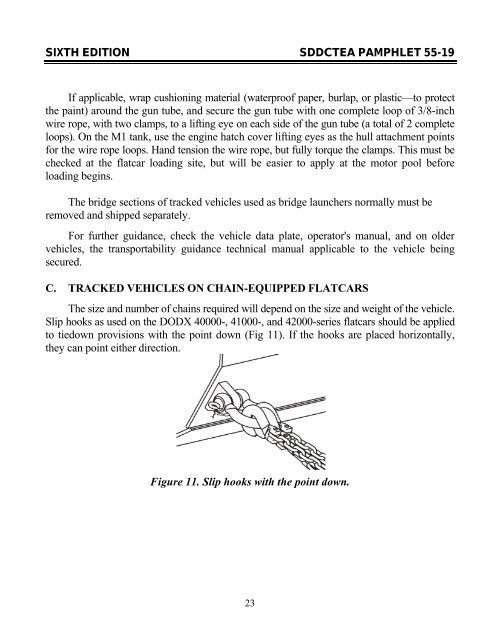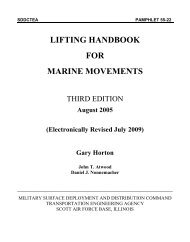Tiedown Handbook For Rail Movements - SDDCTEA - U.S. Army
Tiedown Handbook For Rail Movements - SDDCTEA - U.S. Army
Tiedown Handbook For Rail Movements - SDDCTEA - U.S. Army
Create successful ePaper yourself
Turn your PDF publications into a flip-book with our unique Google optimized e-Paper software.
SIXTH EDITION <strong>SDDCTEA</strong> PAMPHLET 55-19<br />
If applicable, wrap cushioning material (waterproof paper, burlap, or plastic—to protect<br />
the paint) around the gun tube, and secure the gun tube with one complete loop of 3/8-inch<br />
wire rope, with two clamps, to a lifting eye on each side of the gun tube (a total of 2 complete<br />
loops). On the M1 tank, use the engine hatch cover lifting eyes as the hull attachment points<br />
for the wire rope loops. Hand tension the wire rope, but fully torque the clamps. This must be<br />
checked at the flatcar loading site, but will be easier to apply at the motor pool before<br />
loading begins.<br />
The bridge sections of tracked vehicles used as bridge launchers normally must be<br />
removed and shipped separately.<br />
<strong>For</strong> further guidance, check the vehicle data plate, operator's manual, and on older<br />
vehicles, the transportability guidance technical manual applicable to the vehicle being<br />
secured.<br />
C. TRACKED VEHICLES ON CHAIN-EQUIPPED FLATCARS<br />
The size and number of chains required will depend on the size and weight of the vehicle.<br />
Slip hooks as used on the DODX 40000-, 41000-, and 42000-series flatcars should be applied<br />
to tiedown provisions with the point down (Fig 11). If the hooks are placed horizontally,<br />
they can point either direction.<br />
Figure 11. Slip hooks with the point down.<br />
23




